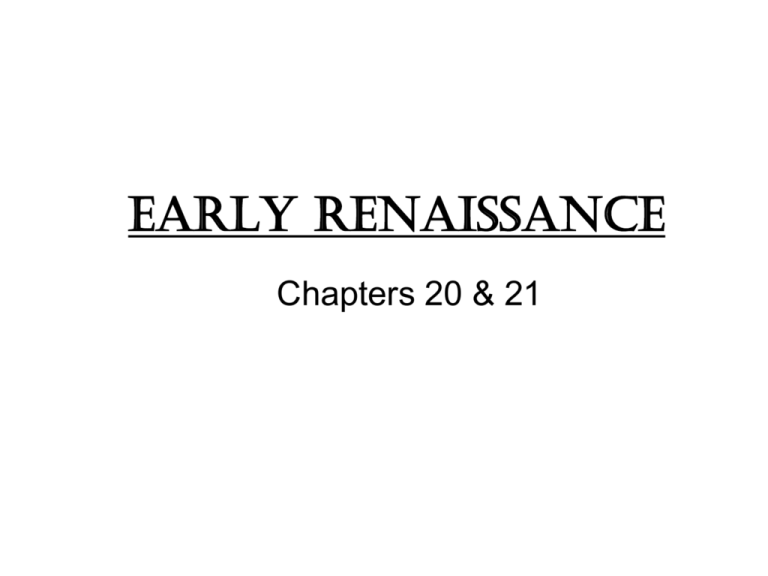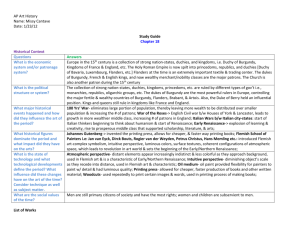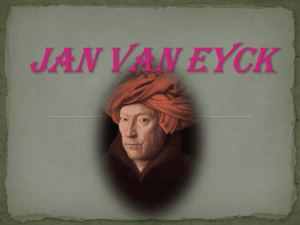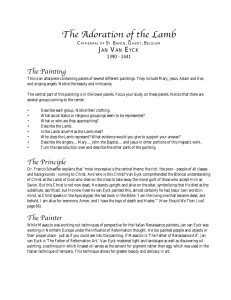File
advertisement

Early Renaissance Chapters 20 & 21 Early Renaissance in the North: Background • Took place in Northern Europe in the trade centers of Flanders (Belgium), Holland, Germany, and France. • Cities vied with one another for the most elaborately decorated cathedrals, town halls, and altarpieces. • Northern artists of the Renaissance were more innovative in painting than in sculpture or architecture. • Secular art becomes increasingly important. • Flemish life integrated secular and religious themes-not meant to be disrespectful-fused together and brought people closer in their faith Northern Painting Masters • Painters preferred oil paint and refined the technique. • Northern artists shared the Italian preference for the representation of 3D space and lifelike figures • Painters preferred sharp, precise details-- some so small you need a magnifying glass to see them. Well of Moses, Claus Sluter, Dijon, France, 1406 • Large sculptural fountain with a Crucifixion (now destroyed) located over a well. This is the base. • Moses holds a copy of his writings, signifying he holds the position as intermediary between God and his people • Horns on his forehead are a reference to having been in the presence of God • Served as a water source for a monastery • This sculpture has immense symbolic importance• -served as a symbolic "fountain of life” • -the blood of Christ flowing down over the Old Testament prophets represents their sins being washed away and promising everlasting life • Style: – Drapery in solid, heavy waves down the figures – Complex surfaces seem naturalistic – Differentiated characteristics – -coarse drapery – -smooth flesh – -silky hair – Rounded, solid volumes – Resembles Gothic jamb sculptures May, Les Tres Riches Heures, Limbourg Brothers, 1406, Illumination • The Very Rich Hours of Duke the Berrycommissioned work by Duke of Berry (within Burgundy, eastern France) • Series of 12 illuminated manuscript paintings with months of year used as a Book of Hours. • Most famous 15th century illuminated manuscript •Rich with costume detail, lightheartedness, chivalry, and elegance •Reflects the artists' interest in precise detail and rich color •The Limbourg Brothers expanded conventional ranges of subject matter to include genre subjects and gave everyday scenes a prominent place in art. • A group of patrician ladies and gentlemen, preceded by trumpeters, ride out to celebrate the first day of May (a traditional spring festival in Northern Europe) • The people are dressed in springtime green and fresh-leaved garlands Another sceneTres Riches Heures, February The Ghent Altarpiece, Jan Van Eyck, Flemish Renaissance, oil on panel, 1432, Belgium Ghent Altarpiece, with wings open •Van Eyck trained as a miniaturist and illuminator of manuscripts, his detail is microscopic. Extreme realism. •Commissioned by a Church dedicated to J the Bap. •This is a polyptych-many paneled painting. On the salvation from Original Sin of Adam and Eve •Celebrates the Christian cycle from the Fall to the Redemption- the entire piece amplifies the central theme of salvation- Exterior • Includes donors at top of the painting, kneeling with hands clasped in prayer • Upper Register- Annunciation scene appears as a representation of a Flemish town Interior • Top- God the Father is in the center, sits in Majesty wearing the Pope’s crown, surrounded by Mary and John the Baptist, and choirs of angels • Adam and Eve appear in the corners • Shown in hierarchical scale Deposition, Rogier Van der Weyden, Flemish Renaissance, oil on wood, 1435 3 • Deposition- taking Christ down from the cross • had a great impact on northern painting • created fluid and dynamic compositions stressing human action, emotion, and drama • He is known for moving observers emotionally by relating to the sufferings of Christ • This is the center panel of the triptych commissioned for the church of Notre Dame in Belgium • Van der Weyden's depiction of the agony of loss is among the most authentic in religious art. • Acknowledged patrons by incorporating a cross bow, the Archer’s Guild's symbol, into the corners • Shallow stage for figures jammed into a confining space, meant to concentrate the viewers attention • Superior attention to details such as elaborate, rich colors and patterns • Figures are in a mirrored composition: Christ and Mary are both end figures and have very similar poses • Adam's skull is a reminder that the Crucifixion took place over his grave The Last Supper, Dirk Bouts, Flemish Renaissance, oil on wood, 1468 • Believed to be the first Northern painting to demonstrate the use of a single vanishing point for constructing an interior – Linear perspective already being used in Italy • All of the room's lines lead to a single point in space in the center of the mantle piece above Christ's head • First Northern artist who adjusted figures' scale to correspond to the space they occupied • Used a hierarchal scale for Christ; Christ is the center of focus Linear Perspective • Scientific/mathematical method of creating the illusion of 3D space on a 2D surface using a vanishing point, horizon line, and orthagonal lines Portinari Altarpiece, Hugo Van der Goes, Flemish Renaissance, tempera & oil on wood, 1470 • placed in the chapel of Santa Maria Nuovo Hospital complex • Commissioned by Tomasso Portinari • Its placement in the hospital chapel influences imagery: – Mary, mother of Christ, is central – St. Margaret, patron saint of childbirth, is on the right wing with a dragon at her feet – Plants in the foreground have medicinal value and symbolic associations • Sheaf of wheat that symbolizes the Eucharist bread • Contains a continuous landscape throughout the three panels. • High horizon typical of Flemish style. • The figures are of different scales- some very large, some much smaller (disproportionate) • Donors and three of their seven children are in side panels, kneeling before their patron saints • Central panel: Mary, Christ child, shepherds falling to their knees • Left panel: Saints present alongside Portinari and his sons. Joseph and Mary in background • Right panel: Portinari’s wife alongside St. Margaret, three wise men Merode Altarpiece, Robert Campin, Flemish Renaissance, Triptych/Oil on Wood, 1427 • Artist depicted a well-kept middle class Flemish home as the site of the Annunciation • Private devotional piece with images of donor placed inside-donor portrait • Left panel– Donors, middle class people, are kneeling before the holy scene • Center panel– Annunciation is taking place in everyday Flemish interior • Right panel– Joseph in his carpentry workshop – Mouse trap symbolizes the capturing of the Devil by using Jesus as bait • Contains a wealth of Christian symbols– The towels and the water basin symbolize Christ cleansing the sins of the world – The lilies have three buds referring to the holy trinity, the unopened bud represents an unborn Jesus – Mary is blocking the fireplace, which signifies the entrance to hell – The candlestick signifies that Mary is holding Christ in her womb – An angel announcing to Mary that she will be the mother of Christ – Tiny Jesus is comes through the window with his cross as well • Humanization of traditional themes: no halos, domestic interiors, view into Flemish cityscape • Intricate details, elegant and elongated draperies • Steeply rising ground line • Figures are too large for the architecture they sit in • Each panel is seen from a different point • But the light source is consistent and unified FYI • Campin was known as the Master of Flemalle • Ingelbrecht was donor-meant angel bringer • Donor’s wife’s maiden name was Scrynmaker-meant cabinet or shrine maker FYI • Campin was known as the Master of Flemalle • Ingelbrecht was donor-meant angel bringer • Donor’s wife’s maiden name was Scrynmaker-meant cabinet or shrine maker Arnolfini Wedding, Jan Van Eyck, Flemish Renaissance, oil painting, 1434 • Van Eyck was a master of realism-credited with inventing oil painting • Thought to be wedding portrait of Giovanni Arnolfini and Giovanna Cenami • Intense concentration of minute details • Everything symbolizes marriage and its holiness: – Candle burning represents the presence of God – Shoes are cast off to indicate Holy Ground – Dog symbolizes fidelity – The ripe fruit represents fertility – St. Margaret finial on bedpost- patron saint of childbirth – Medallions in the mirror's frame represent the Passion of Christ and the promise of Salvation • Two witnesses in the convex mirror (perhaps Van Eyck) Man in a Red Turban, Jan Van Eyck, Flemish Renaissance, oil on panel, 1433 • Oil on wood • Possibly a self-portrait ***Secular portrait • Great skill and detail in reference to the veins in the bloodshot left eye, the beard stubble, and the weathered aged skin • The man looks directly at the viewer or maybe at himself in the mirror, giving the illusion that from whatever angle the viewer observes the face, the eyes are always returning that gaze • At the top of frame, "As I can" is written; "Jan Van Eyck made this" is across the bottom Garden of Earthly Delights, Hieronymous Bosch, Flemish Renaissance, oil on wood, 1510 Outside, Creation of the World Left Panel, Paradise Left panel: 1. Paradise/The Garden of Eden- the state of humans in an ideal world 2. Signs of evil to come- animals are violent and eating one another 3. Adam and Eve are depicted as thin insubstantial nudes who lack backbone and resolve and act only on their impulses. Central Panel, Garden of Earthly Delights (detail) • Central panel: 1. The Garden of Earthly Delightsthe result of Adam and Eve's sin 2. Primitive humanity indulging in sexual play 3. Presence of fruit and birds suggest fertility 4. Animals suggest sexual perversity Right Panel, Hell 3 • Right panel: 1. Hell- the result of the activities in the central panel 2. Souls are tormented by demons and made to pay for excesses on earth 3. Musical instruments are used as symbols of torture • The altarpiece is believed to symbolize the four stages of alchemy: 1. Bringing together of opposite elements (left panel) 2. The mixing of the opposite elements (central panel) 3. The purification process by fire (right panel) 4. The cleansing of the elements (not a panel) • Figures light and unsubstantial, lack individuality and will, have no minds of their own • Some scholars attribute this triptych as a Last Judgment- a warning to the viewer of the fate awaiting the sinful, decadent and immoral • High horizons allow for many details to be packed in the paintings • Bosch's moralistic paintings suggested inventive torments meted out a punishment for sinners • Future Surrealists viewed Bosch as their patron saint Avignon Pieta, Enguerrand Quarton, French Ren., 1455, oil on wood Saint Anthony Tormented by Demons, Martin Schongauer—German Ren., 1490, Engraving • 4th c. saint who was a hermit in the woods • underwent violent temptations, both spiritual and physical, but overcame them. • Horrifying demons and spirits of all types beset Saint Anthony, torturing him almost beyond endurance • Precise details; tight, vibrant forms; thin emaciated figures • Engraving- incised into a metal surface and printed






